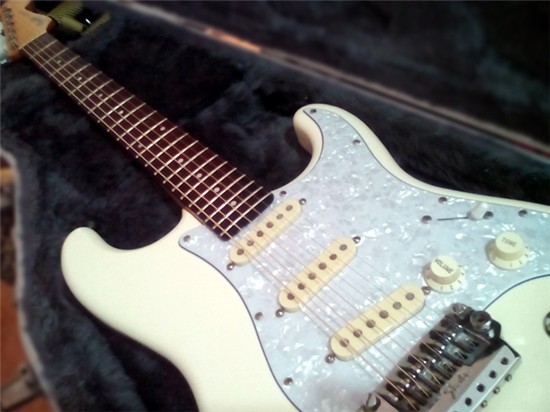 The client had a spec - to change the plain white scratch-plate on his Fender Stratocaster to something a bit more exotic. We emailed, we talked and after trawling several websites, he sent me a link to the scratch-plate of his dreams. The one he chose was a mother of pearl effect that cost about thirty dollars. I immediately went to some Chinese websites and found the same scratch-plate for about three dollars. Had to wait a couple of weeks for it to arrive in the mail but the client was happy as I passed the saving onto him.
The client had a spec - to change the plain white scratch-plate on his Fender Stratocaster to something a bit more exotic. We emailed, we talked and after trawling several websites, he sent me a link to the scratch-plate of his dreams. The one he chose was a mother of pearl effect that cost about thirty dollars. I immediately went to some Chinese websites and found the same scratch-plate for about three dollars. Had to wait a couple of weeks for it to arrive in the mail but the client was happy as I passed the saving onto him.
Out of the box the new scratch plate looked fine, though when I actually came to fit it, there was a problem near the bridge. The new scratch plate had a cutaway section for the old style tremolo whereas this guitar has a Fender floating trem which is bigger and has the two bridge posts right where the new scratch-plate needed to go. Since I'm starting to get more and more of this sort of of work I decided to document each step and record the time for each, so I know how much to charge. Here is how the job went....
Step One (15mins) - Removed existing scratch plate and unscrewed all the hardware. First surprise - the pickups were non standard. The new pickups were the Bare Knuckle Rory Gallagher Irish Tour set.
Step Two (5 mins) - The tremolo block was a bit grubby so I sprayed a ton of WD40 on it and left it to soak for a while.
Step Three (10 mins) - The fret-board was a but grubby too so I cleaned it with lemon oil.
Step Four (5 mins) - Polished the guitar body which was especially dirty where the scratch plate had been.
Step Five (40 mins) - Compared the scratch-plates and found them not quite the same, so marked out a new shape around the tremolo and routed by hand with a Dremel on its lowest setting so as not to melt the plastic. This was the trickiest bit of the project so I took my time to get it absolutely right.
Step Six (10 mins) - Attached the hardware to the new scratch plate
Step Seven (10 mins) - Attached scratch plate to the guitar body. Found two holes were misaligned so had to drill pilots for two new ones.
Step Eight (90 mins) - Replaced strings. Setup for new strings. These were a much heavier set and I needed to dig out a fifth spring to attach to the tremolo block to handle the increased tension, and adjustment was also required to the intonation.
It's always tempting to think of something like changing a scratch-plate as a trivial five minute job, but as this miniature 'time and motion study' shows, this job took a shade over three hours.